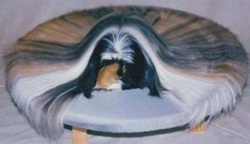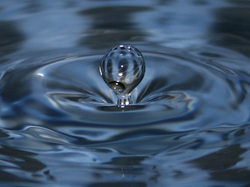Coat & skin
You should brush your guinea pig daily. Brushing not only gives you bonding time, but it’s also a good time to check for problems (more about this below). It can also help prevent problems. Guinea pigs can get hairballs (like cats), so if you get rid of all of the loose hair for them, they are less likely to suffer from hairballs. Guinea pigs tend to shed more in early fall (when they are starting to get their winter coat) and in the spring when they are getting rid of that heavy coat.
You will need a soft brush or comb for your guinea pig. When you brush your pig, start brushing at the back of the head and work down the back (in the direction the hair grows).
Long-haired cavies will need haircuts about every two months. You’ll need additional tools for this, and you’ll have to be very gentle when removing the mats. Peruvian piggies may need to have their long hair wrapped, as well. Owners of long-haired breeds should do more research on grooming their piggies.
While you’re brushing your piggy, watch for patches of missing fur. Some skin problems are caused by a fungus and can be contagious and even spread to people. Contact your vet if you notice a problem.
Guinea pigs keep themselves very clean. Never give your guinea pig a bath unless your vet tells you to or unless you are showing them. Instead, use a washcloth to clean the area that needs cleaned and make sure the piggy is completely dry before you put him back in the cage. Otherwise, he can get sores and he will attract egg-laying flies.
If you do have to give your piggy a bath, be sure to use shampoo specially formulated for small animals. Other shampoos are usually too harsh. Use warm water and a small amount of shampoo. Keep it out of her eyes and ears. Make sure you hold on to your piggy because she’ll get slippery! Make sure you thoroughly rinse your piggy, wrap her in a towel and make sure she’s thoroughly dry before going back to the cage.
Skin
Watch for parasites, such as lice, mites, fleas and ticks. Lice are small, flat insects. You can usually tell if your pet has them because your pet will scratch a lot and probably have some bald spots.
Mites are too small to see, but they make your pet itchy and cause bald spots too. You can get rid of them with chemicals that your vet will give you.
Lumps or sores on the skin can also be a problem. You’ll want to check the bottoms of the feet for sores, too.
Contact your vet immediately if you see any sign of these pests or injuries.
You should brush your guinea pig daily. Brushing not only gives you bonding time, but it’s also a good time to check for problems (more about this below). It can also help prevent problems. Guinea pigs can get hairballs (like cats), so if you get rid of all of the loose hair for them, they are less likely to suffer from hairballs. Guinea pigs tend to shed more in early fall (when they are starting to get their winter coat) and in the spring when they are getting rid of that heavy coat.
You will need a soft brush or comb for your guinea pig. When you brush your pig, start brushing at the back of the head and work down the back (in the direction the hair grows).
Long-haired cavies will need haircuts about every two months. You’ll need additional tools for this, and you’ll have to be very gentle when removing the mats. Peruvian piggies may need to have their long hair wrapped, as well. Owners of long-haired breeds should do more research on grooming their piggies.
While you’re brushing your piggy, watch for patches of missing fur. Some skin problems are caused by a fungus and can be contagious and even spread to people. Contact your vet if you notice a problem.
Guinea pigs keep themselves very clean. Never give your guinea pig a bath unless your vet tells you to or unless you are showing them. Instead, use a washcloth to clean the area that needs cleaned and make sure the piggy is completely dry before you put him back in the cage. Otherwise, he can get sores and he will attract egg-laying flies.
If you do have to give your piggy a bath, be sure to use shampoo specially formulated for small animals. Other shampoos are usually too harsh. Use warm water and a small amount of shampoo. Keep it out of her eyes and ears. Make sure you hold on to your piggy because she’ll get slippery! Make sure you thoroughly rinse your piggy, wrap her in a towel and make sure she’s thoroughly dry before going back to the cage.
Skin
Watch for parasites, such as lice, mites, fleas and ticks. Lice are small, flat insects. You can usually tell if your pet has them because your pet will scratch a lot and probably have some bald spots.
Mites are too small to see, but they make your pet itchy and cause bald spots too. You can get rid of them with chemicals that your vet will give you.
Lumps or sores on the skin can also be a problem. You’ll want to check the bottoms of the feet for sores, too.
Contact your vet immediately if you see any sign of these pests or injuries.



